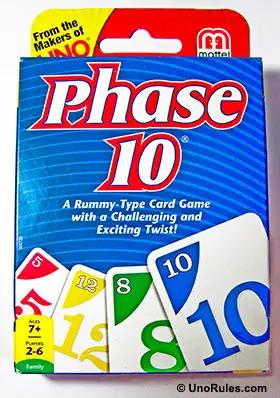 Phase 10 is another popular card game by Mattel, the makers of Uno. This card game resembles Rummy, but the main difference is that you have to complete 10 different types of match-ups or Phases, in order to win the game. The first player to complete all 10 Phases wins the game. It was originally created in 1982 by a man named Kenneth R Johnson, and marketed by a company called Fundex, who sold their rights to Mattel in 2010.
Phase 10 is another popular card game by Mattel, the makers of Uno. This card game resembles Rummy, but the main difference is that you have to complete 10 different types of match-ups or Phases, in order to win the game. The first player to complete all 10 Phases wins the game. It was originally created in 1982 by a man named Kenneth R Johnson, and marketed by a company called Fundex, who sold their rights to Mattel in 2010.
Phase 10 is a bit like Uno, in that you are always trying to get rid of all the cards in your hand and be the first to do it for all hands. But unlike Uno, getting rid of your cards is not your main goal; the goal is to construct and complete your Phases (also called melds), from Phase 1 all the way to Phase 10. Discarding all your cards in hand for each round is the secondary objective (but important as well, as we shall see).
Introduction
Phase 10 seems simpler than Uno since there are less types of cards, but don’t be fooled. The game can be quite challenging to win, especially since you need to constantly slow down your opponents, e.g. those who are have already advanced up the Phases ahead of you, and you always find yourself trying to guess which cards the person after you needs – and not provide him/her these cards (by discarding them) if you can help it. A fair amount of luck is involved; if you’ve been dealt a favorable hand of cards, it ensures a speedy Phase completion.
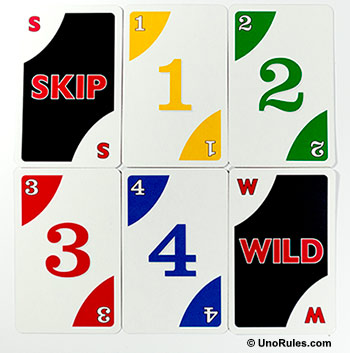 Each box of Phase 10 comes with 110 cards. There are 2 identical Reference cards (each listing the 10 Phases), and 24 x 4 numbered cards of Red, Blue, Green, and Yellow cards respectively (each color in two sets of numbers 1 to 12). Besides them, you have 4 Skip cards, and 8 Wild cards. These symbol cards are very important to the game, as we shall see.
Each box of Phase 10 comes with 110 cards. There are 2 identical Reference cards (each listing the 10 Phases), and 24 x 4 numbered cards of Red, Blue, Green, and Yellow cards respectively (each color in two sets of numbers 1 to 12). Besides them, you have 4 Skip cards, and 8 Wild cards. These symbol cards are very important to the game, as we shall see.
Skip Card – This card enables you to force someone to skip or lose a turn for that particular rotation/round. Once you discard or play it down, you can choose anyone to lose their turn. The Skip card may not be picked up from the Discard Pile, only from the Draw Pile. If it’s the first card to be turned up at the start of the game, the first player to start will lose a turn.
Wild Card – This is the most powerful card of all, and a life saver. You can use a Wild card to replace any card in your Phase, even though you lack that number or color. Any number of Wild cards can be played down on your turn if you have them, as long as you have a single normal card to lay down when you form your Phase. Once a Wild card is laid down as part of a Phase, it cannot be picked up and re-used elsewhere. If turned up at the beginning (to form the Discard pile), the first player to start can pick it up.
What is a Phase?
A Phase is a combination of cards that fulfils the Phase criteria for the particular player, which the player lays down in front of them in view of the other players. Each player has to complete all 10 Phases of the game and if they fail to complete a certain Phase in a hand, he/she must try again in the next hand. A hand ends when someone manages to form a Phase and discard all his/her cards in hand. According to Phase 10 rules, the official 10 Phases are:
- Phase 1 – 2 sets of 3
- Phase 2 – 1 set of 3 and 1 run of 4
- Phase 3 – 1 set of 4 and 1 run of 4
- Phase 4 – 1 run of 7
- Phase 5 – 1 run of 8
- Phase 6 – 1 run of 9
- Phase 7 – 2 sets of 4
- Phase 8 – 7 cards of a color
- Phase 9 – 1 set of 5 and 1 set of 2
- Phase 10 – 1 set of 5 and 1 set of 3
For those Phases which require more than 2 combinations, e.g. Phase 1, you must have all the cards in hand ready to form BOTH combinations, before you lay them down; one combination is not enough, neither are any partial Phases acceptable.
A Set is defined as two or more cards with the SAME number. Color is unimportant here. For example, if you have three “9s” and three “2s” and three “5s”, you have enough cards to complete Phase 1 during your turn. Choose two of the sets and lay them down, while getting rid of the rest by discarding them
A Run is defined as four or more numbered cards that are sequential. For example, you might have the cards “1”, “3”, “4”, “5”, “6”, “8”, “10”, “10”, a “Wild”, and a “Skip”. Your task is to build Phase 2. You can select “3”, “4”, “5”, and “6” as a Run of 4. Color is irrelevant here. Meanwhile, the “10”, “10”, and “Wild”, can complete a Set of 3.
A group of one color (as in Phase 8), is simply defined as all cards being of the same color. Numbers are irrelevant here, including repetitive numbers. It can be all seven green cards, or seven blue cards, or seven red cards.
Gameplay
Phase 10 can be played by 2 to 6 players. Choose a dealer to shuffle and deal out 10 cards face down, to each player. Players should not show their cards to one another. The remaining cards are placed in the center of the group to form the Draw Pile. A card is then turned over and placed next to it. This is the Discard Pile.
Like Uno, the player to the dealer’s left typically starts first and then play proceeds in a clockwise direction. Draw a card from either the Draw Pile or the Discard Pile, and add it to your hand. And then, discard any card that you want onto the Discard Pile.
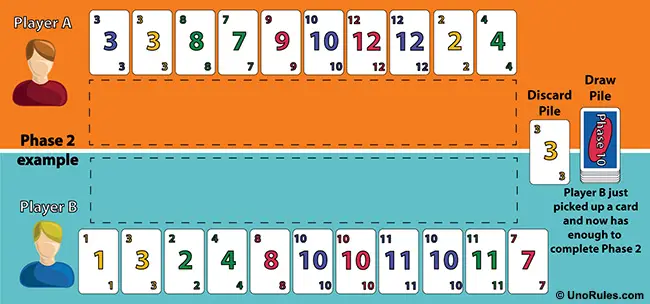
This is an example array prior to building a Phase, in this case, the second Phase.
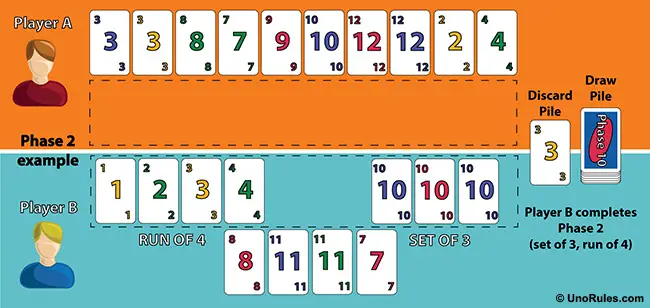
If you have the required cards, you can then proceed to build your Phase.
During your turn, if you can make a Phase, make sure you have all the required cards to form the Phase before laying them down face up in front of you. If not, after drawing and discarding your cards, play moves on to the next person in turn.
Each round is played in a clockwise direction, until finally, someone completes their Phase and goes out. The first player to go out wins the hand. Scores are recorded (please see below), and the player to the left of the dealer becomes the new dealer for the new hand. All cards are gathered back in the deck (after scores are tallied), shuffled, and dealt again to all the players by the dealer.
A new hand now begins. If you have been working on a Phase but couldn’t complete it in time before the hand was over, you now need to work on that Phase again.
What is Hitting?
Hitting is the only way to get rid of 2 or more cards in hand during a player’s turn (immediately after laying down their Phase). Otherwise, you would always be picking up one card and then discarding one card during your turn; of course, the net result is this would not reduce the amount of cards in your hand.
Hitting is discarding any suitable cards in your hand by adding them to your Phase or to another player’s completed Phase. Let’s say, you already completed Phase 4, which is a Run of 7. You already laid down a full set of numbers – “5”, “6”, “7”, “8”, “9”, “10”, and “11”. You have a few cards left in hand, a number “1”, “3”, a “Wild” and another “7”. Another player has also finished building their Phase, which was 2 Sets of 3, and they have laid down 3 cards of number “1” and number “3”. Immediately after completing your Phase, you can discard your “1” and “3” by adding them to your opponent’s Phase, and then adding the Wild card to either your opponent’s Phase or your own (since Wild cards are so versatile). You are now left with a sole 7 card which you can discard onto the Discard Pile, and thus be the first player to get rid of all your cards and go out of the round.
Being the first to go out
The first player to go out of the round (also described as winning the hand), advances to the next Phase/hand along with all the players who have also completed their existing Phases. Finishing first has its benefits. All the others who did not finish discarding all their cards ahead of you for that hand, must now count or total up their remaining cards in hand.
The fewer remaining cards one has at the end of each hand, the better it will be. Obviously, the winner of the hand will not have to count any cards, since he/she will have none (zero). The scoring is as follows:
- Each numbered card from 1-9 scores 5 points each
- Each numbered card from 10-12 scores 10 points each
- Each Skip card scores 15 points each
- Each Wild card scores 25 points each
The points scored for each hand are not a positive thing for any player. The more points someone has, the worse it is for that player, because in Phase 10, the player with the lowest score is always the winner!
Winning the Game
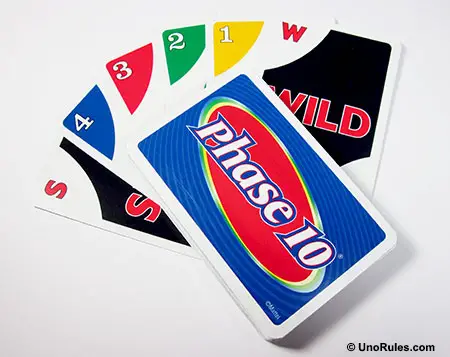 The winner is the first person who completes Phase 10 at the end of a hand. The first player to complete Phase 10 will always have the lowest score. In the event of a tie (when two or more players have completed Phase 10), the winner is also the player with the lowest score. If the scores are the same and it’s still a tie, the tied players replay a hand and try to complete Phase 10 again. The first player to go out is declared the winner.
The winner is the first person who completes Phase 10 at the end of a hand. The first player to complete Phase 10 will always have the lowest score. In the event of a tie (when two or more players have completed Phase 10), the winner is also the player with the lowest score. If the scores are the same and it’s still a tie, the tied players replay a hand and try to complete Phase 10 again. The first player to go out is declared the winner.
Alternative Gameplay
Phase 10 has sometimes been described by some as being too lengthy. According to Mattel, here are some proposed ways to reduce the time to play through an entire game.
- The first method is to disregard the Phases and yet play 10 hands. Yes, everyone tries to achieve the Phases for each hand, but after a player goes out, the hand is over, and everyone advances to the next Phase. In the 1st hand, everyone tries to achieve Phase 1. In the 2nd hand, everyone tries to achieve Phase 2. And so forth. Finally, the one with the lowest score is the winner.
- The second method is to settle for a reduced Phase count, but everyone must agree on it before the game starts. You might want to just play until Phase 5 or Phase 6. This significantly reduces the play time.
The third method is to either play only the even or odd Phases (Phases 2, 4, 6, 8, 10 or Phases 1, 3, 5, 7, 9). In every variation, all the rules remain the same.